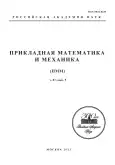On Splitting of Separatrices Corresponding to the Working Mode of the Watt Regulator
- Authors: Markeev A.P.1
-
Affiliations:
- Moscow Aviation Institute
- Issue: Vol 87, No 5 (2023)
- Pages: 720-728
- Section: Articles
- URL: https://journals.rcsi.science/0032-8235/article/view/232501
- DOI: https://doi.org/10.31857/S0032823523050107
- EDN: https://elibrary.ru/QNUWBI
- ID: 232501
Cite item
Full Text
Abstract
The nonlinear problem of the Watt regulator dynamics is investigated. It is assumed to be installed on a machine that performs the specific harmonic oscillations of small amplitude along the vertical. Viscous friction forces is believed to arise in the hinges of the regulator, and these forces are small. In the main operating mode of the regulator, its rods, carrying massive weights, are deflected from the downward vertical by a constant acute angle. If friction and vertical oscillations of the machine are neglected, then we obtain an approximate problem in which the dynamics of the regulator is described by an autonomous Hamiltonian system with one degree of freedom. On the phase portrait of the approximate problem, the operating mode corresponds to a singular point of the center type. The trajectories surrounding this point lie inside the separatrix, which is a homoclinic doubly asymptotic trajectory that passes through the equilibrium position corresponding to the vertical position of the rods with weights. In the phase portrait, this position corresponds to a saddle singular point. The Melnikov method is used to obtain the splitting condition for the unperturbed separatrix in the complete perturbed problem, taking into account dissipation in the hinges and vertical vibrations of the machine.
Keywords
About the authors
A. P. Markeev
Moscow Aviation Institute
Author for correspondence.
Email: anat-markeev@mail.ru
Russia, Moscow
References
- Maxwell D.K., Vyshnegradskii I.A., Stodola A. Theory of Automatic Control (Linearized Problems). Moscow: Izd-vo AN SSSR, 1949. 431 p. (in Russian)
- Zhukowskiv N.E. Theory of Machine-Motion Control. In Coll. Works. Vol. 3. Moscow;Leningrad: Gostekhizdat, 1949. p. 392. (in Russian)
- Appel P. Theoretical Mechanics. Vol. 2. Moscow: Fizmatgiz, 1960. 487 p. (in Russian)
- Targ S.M. Brief Course of Theoretical Mechanics. Moscow: Vysshaya Shkola, 2009. 416 p. (in Russian)
- Zhuravskii A.M. Handbook on Elliptic Functions. Moscow: Izd-vo AN SSSR, 1941. 235 p. (in Russian)
- Andronov A.A., Vitt A.A., Khaikin S.E. Theory of Vibrations. Moscow: Fizmatgiz, 1959. 915 p. (in Russian)
- Pontryagin L.S. Ordinary Differential Equations. Moscow: NITs “R&C Dyn.”, 2001. 400 p. (in Russian)
- Markeev A.P. Watt regulator dynamics // Dokl. Phys., 2017, vol. 62, no. 12, pp. 538–542.
- Malkin I.G. Some Problems in the Theory of Nonlinear Oscillations: In 2 Vols. Germantown, Md.: US Atom. Energy Commis., Techn. Inform. Serv., 1959.
- Melnikov V.K. On the stability of a center for time-periodic perturbations // Trans. Mosc. Math. Soc., 1963, vol. 12, pp. 3–52. (in Russian)
- Kozlov V.V. Integrability and non- integrability in Hamiltonian mechanics // Rus. Math. Serv., 1983, vol. 38, no. 1, pp. 1–76.
- Arnol’d V.I., Kozlov V.V., Neishtadt A.I. Mathematical Aspects of Classical and Celestial Mechanics. Encycl. Math. Sci. Vol. 3. Berlin: Springer, 2006. 505 p.
- Gradstein I.S., Ryzhik I.M. Tables of Integrals, Sums, Series and Products. Moscow: Nauka, 1971. 1108 p. (in Russian).











